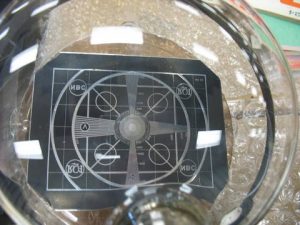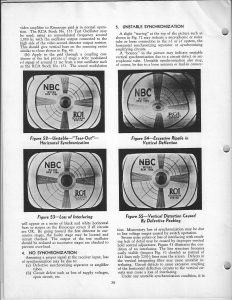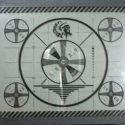Please adjust your television set: troubleshooting in the time of black and white television
Before the rise of the 24-hour television and the broadcasting of reruns or infomercials in the wee hours of the morning, television stations would sign off for the night, typically at 2am, to return again the next morning. Also, in the earliest days of television, there was not enough programing to fill the tube with a day’s worth of shows, so at periodic intervals, television stations would broadcast what is called a test pattern, a still image that allowed for television troubleshooting. On any given day, at any given point, someone, somewhere would be transmitting a test pattern.
There had never been any one standard standard test pattern in general use. Early television researchers used whatever struck their fancy to calibrate their equipment: Philo Farnsworth used shapes like triangles and dollar signs, the latter because his investors were clamoring to see the profits from the new technology; the Scottish inventor John Baird used a ventriloquist dummy known as Stooky Bill; and RCA’s experimental station (W2XBS) used an image of Felix the Cat. However, as television became a more established medium, other, more informative, test patterns came into use. While the Radio Television Manufacturers Association (RTMA) did propose a standard resolution chart to be used by all television stations for this purpose, for a variety of reasons, it was not widely adopted. Instead, the closest thing there was to a standard was the RCA “Indian Head” pattern.


The test pattern, before being produced in a card, as in S. 509, was introduced in Harrison, NJ in 1939 in the RCA TK-1 monoscope. A monoscope is a special kind of cathode ray tube (CRT) that, rather than capturing a television image, was meant to display an image built directly into a tube. These images were etched onto a metal plate, and once the tube was manufactured, the image could not be changed out. These images were often things like test patterns or other standard announcements that had to be aired periodically. The Sarnoff Collection has one of these monotubes, a 1939 early type 1850 Iconoscope with the RCA-NBC test pattern on it (not, alas, the “Indian Head”). These test patterns were meant to make sure that a television was properly tuned. A technician could use the test pattern broadcast onto a television set and adjust for size and linearity, centering, focus, contrast and brightness, interlacing, and horizontal and vertical resolution. Sometimes, however, it would be the fault of the stations, who would have a poor quality transmitted signal, making life frustrating for television technicians.

In the 50s and 60s, test patterns like the Indian Head were phased out, and as color television became more prominent, they were replaced by the SMPTE Color Bars. Now, television stations rarely go off the air, and if they do, there is no need for the test pattern any longer. Instead, the RCA Indian Head test pattern lives on as a symbol of the early days of the American television industry.
Text by: Florencia Pierri

